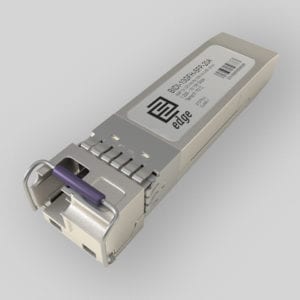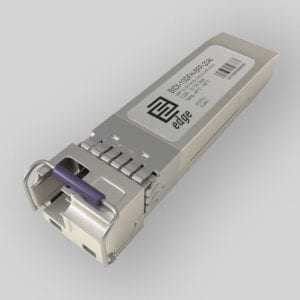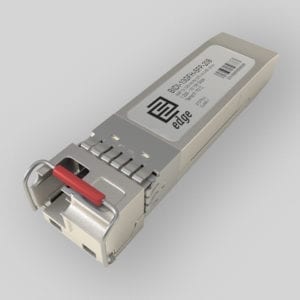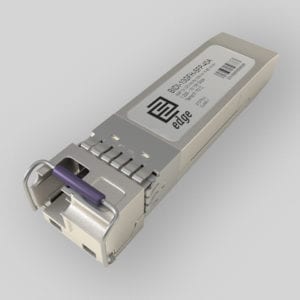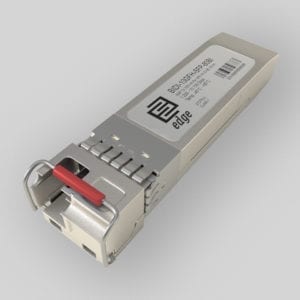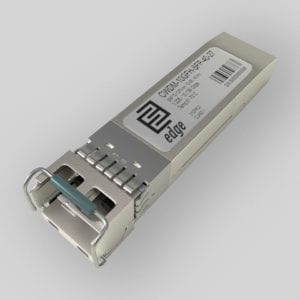Our legacy CPRI/OBSAI line focuses on 3G/4G Mobile Fronthaul Networks, which do not require as high networking speeds between RRU (Remote Radio Unit) and BBU (Baseband Unit) as 5G Mobile Networks and therefore transmission requirements can be fulfilled by 10G FH (Fronthaul) SFP+ (Small Form-Factor Pluggable) Optical Transceivers. Depending on the base station manufacturer standard preference these transceivers are coded either for CPRI (Common Public Radio Interface) or OBSAI (Open Base Station Standard Initiative) bit rates. Our legacy CPRI/OBSAI 10GFH support CPRI Option 8 (10.138 Gbps), CPRI Option 7 (9.830 Gbps), CPRI Option 6 (6.144 Gbps), CPRI Option 5 (4.915 Gbps), CPRI Option 3 (2.458 Gbps), CPRI Option 2 (1228.8 Mbps) and OBSAI RP3 x 8 (6.144 Gbps), OBSAI RP3 x 4 (3.072 Gbps), OBSAI RP3 x 2 (1.536 Gbps) rates. Overall we see that CPRI has become the mainstream standard for BBU and RRU interconnection in our industry and is used by the majority of mobile base station manufacturers, however there can be exceptions.

In our legacy CPRI/OBSAI line there are available Standard Temperature modules (0 to 70 Celsius) for use in typical telecom environments and Industrial Temperature (-45 to 85 Celsius) modules for use under harsh environments, like mobile base station towers, unheated outdoor cabinets.
Typical Legacy CPRI/OBSAI mobile fronthaul deployment scenarios are:
- Double Fiber – this is a standard approach where RRUs are connected to BBUs over 2 fiber connections, for example:
- 10GFH SR (Short Range) CPRI/OBSAI, applications up to 400 meters over OM4/OM5 fiber
- 10GFH LR (Long Range) CPRI/OBSAI, applications up to 10km over OS2 fiber
- 10GFH ER (Extended Range) CPRI/OBSAI, applications up to 40km over OS2 fiber
- 10GFH ZR CPRI/OBSAI, applications up to 80km over OS2 fiber
- Single Fiber – with this approach we can use 2 times less fiber resources compared to the Double Fiber approach. RRUs are connected to BBUs over 1 fiber and use WDM (Wavelength Division Multiplexing) couplers, which combine and separate data transmitted over a single fiber based on the wavelengths of the light. To elaborate, at one side (Side A) we have optical transceiver with Tx: 1270nm and Rx: 1330nm wavelength and on the opposite side of the single fiber link (Side B) we have optical transceiver with Tx: 1330nm and Rx: 1270nm wavelength. Based on the above we use WDM principles and achieve bidirectional transmission over single fiber and we can have such scenarios as:
- BIDI (bidirectional) 10GFH LR (Long Range) CPRI/OBSAI applications up to 10km over OS2 fiber
- BIDI (bidirectional) 10GFH ER (Extended Range) CPRI/OBSAI applications up to 40km over OS2 fiber
- BIDI (bidirectional) 10GFH ZR (Extended Range) CPRI/OBSAI applications up to 80km over OS2 fiber
- Double Fiber or Single Fiber CWDM or DWDM – with help of this approach we can massively reduce fiber needs in fronthaul and for example interconnect BBUs with several RRUs over one fiber in distances up to 80km. Solution consists of colored optical transceivers (CWDM or DWDM) which are used together with xWDM filters. Legacy CPRI/OBSAI 10GFH CWDM (Coarse Wavelength Division Multiplexing) solution use a CWDM channel plan defined by ITU-T G.694.2 (18 wavelengths with 20 nm spacing) and with help of passive CWDM filters we can aggregate/separate different wavelength (nm) connections. With Passive CWDM approach we can design up to 18 Channel CWDM eCPRI double fiber connection or up to 9 Channel CWDM eCPRI single fiber connection between BBU farm and RRU units.
Legacy CPRI/OBSAI 10GFH DWDM (Dense Wavelength Division Multiplexing) use a DWDM channel plan defined by ITU-T G.694.1 (more specifically 45 channels, from Channel 17 to Channel 61 in DWDM C-Band spectrum with 100Ghz channel spacing) and with help of passive DWDM filters we can aggregate/separate different wavelength (nm) connections.
If we use double fiber between BBU farm and RRUs with passive DWDM we can have up to 45 Channel interconnection or if we use single fiber we can have up to 22 Channel DWDM eCPRI connection.
Legacy CPRI/OBSAI Transceiver product line:
Select needed Tx Wavelength:
Select Line Transmission protocol:
Product Maximum Distance:
- 2 220m
- 2 300m
- 1 2km
- 9 10km
- 6 20km
- 12 40km
- 4 60km
- 10 80km
- 2 100km
Product Media Type:
- 4 Multi-Mode Fiber (MMF)
- 44 Single-Mode Fiber (SMF)
Product Connectors:
- 27 Double LC
- 21 Single LC
Product Temperature Range:
- 25 Industrial -45°C - +85°C
- 23 Standard 0°-70°C
Compatible Vendor Name:
Interface Type:
Product Connector A:
Product Connector B:
Product Fiber count:
Product Fiber Type:
Showing 21–40 of 48 results
-
BIDI-10GFH-SFP-10BI
€16.331.228-10.138 Gbps, 1330 nm, SF. (SMF), Single LC, Industrial -45°C – +85°C
-
BIDI-10GFH-SFP-20A
€15.371.228-10.138 Gbps, 1270 nm, SF. (SMF), Single LC, Standard 0°-70°C
-
BIDI-10GFH-SFP-20AI
€16.331.228-10.138 Gbps, 1270 nm, SF. (SMF), Single LC, Industrial -45°C – +85°C
-
BIDI-10GFH-SFP-20B
€15.371.228-10.138 Gbps, 1330 nm, SF. (SMF), Single LC, Standard 0°-70°C
-
BIDI-10GFH-SFP-20BI
€13.661.228-10.138 Gbps, 1330 nm, SF. (SMF), Single LC, Industrial -45°C – +85°C
-
BIDI-10GFH-SFP-40A
€16.331.228-10.138 Gbps, 1270 nm, SF. (SMF), Single LC, Standard 0°-70°C
-
BIDI-10GFH-SFP-40AI
€17.291.228-10.138 Gbps, 1270 nm, SF. (SMF), Single LC, Industrial -45°C – +85°C
-
BIDI-10GFH-SFP-40B
€16.331.228-10.138 Gbps, 1330 nm, SF. (SMF), Single LC, Standard 0°-70°C
-
BIDI-10GFH-SFP-40BI
€17.291.228-10.138 Gbps, 1330 nm, SF. (SMF), Single LC, Industrial -45°C – +85°C
-
BIDI-10GFH-SFP-60A
€30.521.228-10.138 Gbps, 1270 nm, SF. (SMF), Single LC, Standard 0°-70°C
-
BIDI-10GFH-SFP-60AI
€32.131.228-10.138 Gbps, 1270 nm, SF. (SMF), Single LC, Industrial -45°C – +85°C
-
BIDI-10GFH-SFP-60B
€30.521.228-10.138 Gbps, 1330 nm, SF. (SMF), Single LC, Standard 0°-70°C
-
BIDI-10GFH-SFP-60BI
€32.131.228-10.138 Gbps, 1330 nm, SF. (SMF), Single LC, Industrial -45°C – +85°C
-
BIDI-10GFH-SFP-80A
€160.651.228-10.138 Gbps, 1490 nm, SF. (SMF), Single LC, Standard 0°-70°C
-
BIDI-10GFH-SFP-80AI
€225.231.228-10.138 Gbps, 1490 nm, SF. (SMF), Single LC, Industrial -45°C – +85°C
-
BIDI-10GFH-SFP-80B
€160.651.228-10.138 Gbps, 1550 nm, SF. (SMF), Single LC, Standard 0°-70°C
-
BIDI-10GFH-SFP-80BI
€225.231.228-10.138 Gbps, 1550 nm, SF. (SMF), Single LC, Industrial -45°C – +85°C
-
CWDM-10GFH-SFP-10-XX
€23.61 – €27.251.228-10.138 Gbps, Ch. 27 – Ch. 61 (1270nm – 1610nm), DF CWDM. (SMF), Double LC, Standard 0°-70°C
-
CWDM-10GFH-SFP-10I-XX
€27.251.228-10.138 Gbps, Ch. 27 – Ch. 61 (1270nm – 1610nm), DF CWDM. (SMF), Double LC, Industrial -45°C – +85°C
-
CWDM-10GFH-SFP-40-XX
€23.61 – €154.401.228-10.138 Gbps, Ch. 27 – Ch. 61 (1270nm – 1610nm), DF CWDM. (SMF), Double LC, Standard 0°-70°C


